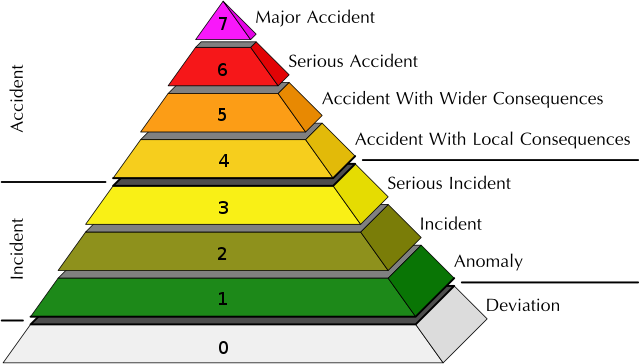The International Nuclear Event Scale (INES) is a system introduced by the International Atomic Energy Agency (IAEA). It was introduced to allow people to communicate how serious a nuclear accident is. Other people are then able to react faster to take protection measures. For each level, there is a list of things that must be there, for the accident to be of that level.
There are 7 levels on the INES scale:
7
Major accident
(maximum credible accident)
Major accident
(maximum credible accident)
6
Serious accident
Serious accident
5
Accident with off-site risk
Accident with off-site risk
4
Accident without off-site risk
Accident without off-site risk
3
Serious incident
Serious incident
2
Incident
Incident
1
Anomaly
Anomaly
0
Deviation, no safety relevance
Deviation, no safety relevance
Details

Level 7 is the highest level. Accidents of this type have a large impact (pollution, radiation) outside the site where they occur. The health of many people is put in danger. There are big effects on the environment. Examples: Fukushima nuclear disaster - 2011, Chernobyl disaster (former Soviet Union) - 1986.
Level 6 Accidents of this type have a large impact (pollution, radiation) outside the site where they occur. Several governments may need to do a lot to protect their population. Example: Mayak (former Soviet Union) 1957. Because of the levels of radioactive materials released, the Mayak accident would probably be rated at level 7 today.
Level 5 Accidents of this type release some radiation. Some groups of people which are at risk may need special countermeasures. Examples: Windscale fire (United Kingdom) - 1957, Three Mile Island accident (United States) - 1979.
The Levels 5-7 are related to severe damage of the reactor core and the radiological barriers.
Level 4 is for significant damage of the reactor core / radiological barriers and/or a fatal exposure of a worker (or more), but the off-site impact is minor, resulting in public exposure of the order of the prescribed limits. Examples: Windscale (United Kingdom) - 1973, Saint-Laurent (France) - 1980, Buenos Aires (Argentina) - 1983.
Level 3 is for very small off-site impact, although related to severe spread of contamination on-site / acute health effects to a worker (or more). It is a "near accident" event, when no safety layers are remaining. Example: Vandellos (Spain) - 1989, THORP plant Sellafield (United Kingdom) - 2005.
Level 2 is an incident with no off-site impact, related to significant spread of contamination on-site / overexposure of a worker.
Level 1 is an anomaly beyond the authorized operating regime.
Level 0 is a "below-scale event" of no safety significance.
There are also events of no safety relevance, characterized as "out of scale".
Other websites
- International Nuclear Event Scale Archived 2006-12-09 at the Wayback Machine, IAEA
- International Nuclear Event Scale, User's Manual Archived 2009-04-11 at the Wayback Machine, IAEA, 2001
Wikiwand in your browser!
Seamless Wikipedia browsing. On steroids.
Every time you click a link to Wikipedia, Wiktionary or Wikiquote in your browser's search results, it will show the modern Wikiwand interface.
Wikiwand extension is a five stars, simple, with minimum permission required to keep your browsing private, safe and transparent.